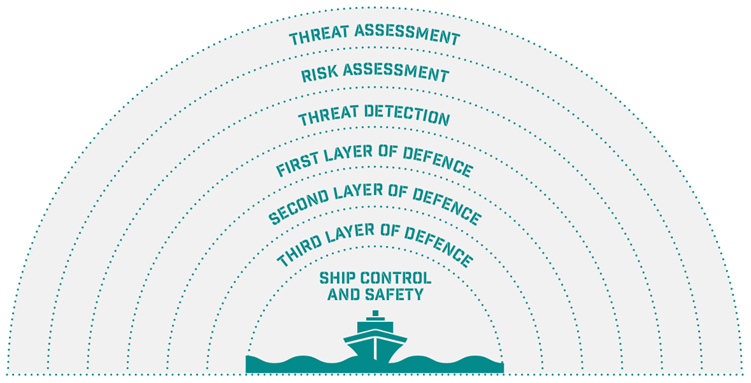Updated 4 June 2025
Although most incidents continue to occur in South-East Asian waters and the African Gulf of Guinea, acts of piracy and armed robbery against ships are not exclusive to these regions. In recent years, robbers have attacked numerous ships at ports and anchorages in South and Central America and since their resurgence in 2023, Somali pirates have targeted both commercial ships and fishing vessels in the Indian Ocean.
Ship operators and masters must therefore make every effort to monitor maritime security threats and incidents in the regions to which their ships will trade, undertake voyage specific risk assessments, and update ship security plans based on the most recent information available. Relevant mitigating measures must be adopted, following available industry guidance and best management practices, and the crew trained and briefed on the equipment and procedures to be used when operating in a piracy and armed robbery prone area. Planning ahead is key!
Below we have provided an overview of Gard’s most relevant publications on this topic. We have also highlight some of the fundamental requirements to avoid attack by pirates and armed robbers and provided links to some of the relevant guidelines and websites that may assist vessel operators, masters and crews to stay alert and prepare and respond to piracy and armed robbery attacks.
Gard material
Bridge emergency reference cards for use in high-risk areas (2024)
GUARDCON West Africa (Member Circular No.1-2014)
BIMCO GUARDCON Contract for the employment of security guards on vessels (Member Circular No.2-2012)
Work of the International Maritime Organization (IMO)
The threat posed by piracy and armed robbery against ships has been on the IMO’s agenda since the early 1980s. Reports of actual and attempted attacks by pirates and armed robbers against ships are continuously promulgated via the Piracy and Armed Robbery module within the IMO’s Global Integrated Shipping Information System (GISIS) as soon as they are received from Member States and reporting organizations. The organization has adopted appropriate guidance aimed at assisting ship operators and crew (MSC.1/Circ.1334) on preventing and suppressing acts of piracy and armed robbery against ships.
A definition of ‘piracy’ can be found in Article 101 of UNCLOS whereas a definition of ‘armed robbery against ships’ can be found in IMO Resolution A.1025(26).
The IMO also supports the various best practice guides developed by the shipping industry and which outline appropriate procedures to be employed when responding to acts or attempted acts of piracy and armed robbery against ships in specific regions. Click here for an overview of the latest guidance adopted by the IMO regarding piracy related matters.
Industry best practice guides
The Maritime Global Security website (https://www.maritimeglobalsecurity.org/) is supported by a number of shipping industry associations, including the International Group of P&I Clubs (IG), and serves as a ‘one stop shop’ for maritime security advice. It provides links to all security-related guidance produced by the industry as well as to many useful maritime and military security resources. Drop-down menus allow users to find relevant information and guidance either based on types of maritime security risks or geography and specific trading areas. Central to the website is a collection of best practice guides to assist companies and mariners to risk assess voyages and detect, avoid, deter or delay piracy attacks, such as the:
Improving the safety of seafarers
In summary, the fundamental requirements of any best practice to avoid, deter and delay attacks by pirates and armed robbers are:
Understand the threat
Gather accurate information on the security situation as part of the voyage planning process. Maritime threats are constantly evolving and obtaining up-to-date information is crucial for effective threat and risk assessment and decision making.
Closely monitor the threat situation by staying in close contact with local sources of information, such as the regional reporting and information centres and ships’ local agents, checking the latest NAVAREA warnings and alerts, and reviewing industry, Flag State, company and military routing advice.
Depending on the threat situation, consider seeking timely expert advice from specialized maritime intelligence agencies to aid the decision-making process.
Assess the risk and determine the mitigating measures to be applied
Carry out a voyage specific threat and risk assessment and review the Ship’s Security Plan.
Identify and adopt relevant mitigating measures by following available industry best practice guidance, such as the BMP MS, to protect the crew and ship, and remember that ships can be attacked both when underway, at anchor and alongside.
Comply with Flag State requirements and military recommendations where applicable.
When considering relevant mitigating measures, apply a ‘layered defence strategy’.

In practical terms, this could mean:
Prioritise measures to prevent attackers from accessing the ship, such as razor wire, water and foam cannon systems, and other physical barriers. The option of re-routing and/or manoeuvring away from potential attackers should be considered.
Secondly, if attackers have gained access to the ship, try to stop or delay them from entering accommodation blocks, ships’ stores and machinery spaces, e.g. by installing locking bars on external doors, window covers, etc.
As a last resort, prevent the attackers from reaching the crew, e.g. by hardening internal doors and establishing a safe muster place with communication to shore/rescuers.
Note also that a proper lookout is considered the most effective method of ship protection. It can help identify a suspicious approach or attack early on, allows defences to be deployed.
Prepare the crew
Brief the crew on the security arrangements identified in the Ship Security Plan.
Conduct regular drills and exercises and capture lessons observed. Many attempted piracy and armed robbery attacks are unsuccessful, countered by ships’ crew who have planned and trained in advance.
Register and report
If the voyage includes the transit of a Voluntary Reporting Area (VRA), register with the respective regional reporting centre when entering the VRA and submit daily ship position reports while operating within the VRA. VRAs are marked on maritime security charts, and the charts provide advice on their use, reporting formats and instructions.
Work together with other operators, military forces, law enforcement bodies and welfare providers in the region when necessary - both before, during and after an attack.
Report all attacks and suspicious sightings to the relevant regional Reporting centre, authorities of the coastal state(s), the ship’s own flag state and to the IMB PRC. The IMB PRC operates on a 24/7 basis and serves as a primary reporting point as well as a response coordination organization at a global level.
Send distress signals when under attack.
Annex A of the BMP MS provides an overview of the key maritime security reporting centres worldwide, describing their roles, services and contact details.
Insurance cover for piracy
The International Group of P&I Clubs has produced a “Piracy- FAQs” document to provide general clarification and guidance on a number of matters concerning insurance cover issues arising out of piracy incidents. It provides an overview of the scope of cover provided by P&I, H&M, and war risks insurance, discusses questions related to engagement of private maritime security guards, and reviews some relevant charterparty issues.
While the questions and answers in the document are focused on piracy in the Indian Ocean, they also apply to piracy and armed robbery against vessels in other similarly affected areas.
Use of external security companies
Armed private security guards
The decision to engage privately contracted armed security personnel (PCASP) onboard ships is an operational one for ship operators. There is no cover restriction or prohibition per se on the engagement of or the use of PCASP and Gard’s current position on this is neutral.
However, to place PCASP onboard a ship should only be considered after a thorough risk assessment and should not be a substitute for, but in appropriate cases, a supplement to effective compliance with the latest versions of industry best practice guides. In making such a decision, we expect our Members and clients to follow the due diligence principles set out by the IMO and ensure they comply with all applicable laws and regulations, including those of their flag state, coastal states and any other relevant authority.
BIMCO has developed an agreement, GUARDCON, for the hire of the services of private security guards onboard ships which, since its inception, has provided contractual certainty for shipowners and private maritime security companies. It continues to serve as the benchmark contract for shipowners and IG clubs and we strongly recommend the use of this agreement. However, as BIMCO’s GUARDCON in its unamended form is not a suitable contract to use for the engagement of PCASPs off West Africa, where it is contemplated armed security personnel provided by littoral states will operate alongside unarmed PCASPs, it is worth noting that the IG Clubs have produced an amended version of the agreement for this purpose, the GUARDCON WEST AFRICA.
Security escort vessels
BIMCO has also launched a separate contract, the SEV-GUARDCON, for shipowners and operators who require security escort vessels (SEVs) when operating in high risk areas. The contract provides a standard set of terms and conditions for engaging escort vessel services and has been drafted to enable cross-border transits where a SEV is needed to accompany a ship through the Exclusive Economic Zone (EEZ) or territorial waters of more than one state. However, as it only applies to the use of SEVs, shipowners who require escort vessel services combined with armed guards onboard their ship should use the SEV-GUARDCON together with a contract for the hire of PCASPs.
All BIMCO contracts and clauses are available at: https://www.bimco.org/contracts-and-clauses
Websites of external information providers
IMO Global Integrated Shipping Information System (GISIS): https://gisis.imo.org
International Chamber of Commerce’s International Maritime Bureau’s Piracy Reporting Center (IMB PRC): https://icc-ccs.org/imb-piracy-reporting-centre-2/
NATO Shipping Centre (NCS): https://shipping.nato.int/nsc
US Office of Naval Intelligence (ONI): https://www.oni.navy.mil/News/Shipping-Threat-Reports/
United Kingdom Hydrographic Office (UKHO) – Security Related Information to Mariners (SRIM): https://www.admiralty.co.uk/maritime-safety-information/security-related-information-to-mariners
The Joint War Committee (JWC) of the Lloyd’s Market Association (LMA): http://www.lmalloyds.com/lma/jointwar
United Kingdom Maritime Trade Operations (UKMTO): https://www.ukmto.org/indian-ocean
EU Maritime Security Centre – Indian Ocean (EU MSCIO): https://www.mscio.eu/
Combined Maritime Forces (CMF): https://combinedmaritimeforces.com/
Marine Domain Awareness for Trade - Gulf of Guinea (MDAT-GoG): https://gog-mdat.org/home
Regional Cooperation Agreement on Combating Piracy and Armed Robbery against Ships in Asia Information Sharing Center (ReCAAP ISC): https://www.recaap.org/
Singapore Information Fusion Centre (IFC): https://www.ifc.org.sg/


